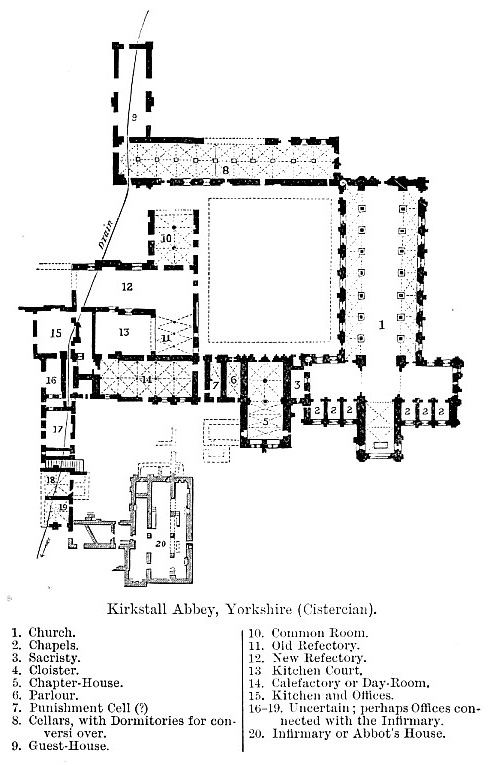1902 Encyclopedia > Abbey > Cistercian Abbeys (cont.): English Cistercian Abbeys; Kirkstall Abbey, Yorkshire.
Abbey
(Part 13)
(C) Cistercian Abbeys (cont.)
English Cistercian Abbeys
The English Cistercian houses, of which there are such extensive and beautiful remains at Fountains, Rievaulx, Kirkstall, Tintern, Netley, &c., were mainly arranged after the same plan, with slight local variations.
Kirkstall Abbey, Yorkshire
As an example, we give the ground-plan of Kirkstall Abbey, which is one of the best preserved and least altered.

Kirkstall Abbey, Yorkshire (Cistercian)
The church here is of the Cistercian type, with a short chancel of two squares, and transepts with three eastward chapels to each, divided by solid walls (2 2 2). The whole is of the most studied plainness. The windows are unornamented, and the nave has no triforium. The cloister to the south (4) occupies the whole length of the nave. On the east side stands the two-aisled chapter-house (5), between which and the south transept is a small sacristy (3), and on the other side two small apartments, one of which was probably the parlour (6). Beyond this stretches southward the calefactory or day-room of the monks (14). Above this whole range of building runs the monks' dormitory, opening by stairs into the south transept of the church. At the other end were the necessaries. On the south side of the cloister we have the remains of the old refectory (11), running, as in Benedictine houses, from east to west, and the new refectory (12), which, with the increase of the inmates of the house, superseded it, stretching, as is usual in Ciestercian houses, from north to south. Adjacent to this apartment are the remains of the kitchen, pantry, and buttery. The arches of the lavatory are to be seen near the refectory entrance. The western side of the cloister is, as usual, occupied by vaulted cellars, supporting on the upper story the dormitory of the lay brothers (8). Extending from the south-east angle of the main group of buildings are the walls and foundations of a secondary group of considerable extent. These have been identified either with the hospitium or with the abbot's house, but they occupy the position in which the infirmary is more usually found. The hall was a very spacious apartment, measuring 83 feet in length by 48 feet 9 inches in breadth, and was divided by two rows of columns. The fish-ponds lay between the monastery and the river to the south. The abbey mill was situated about 80 yards to the north-west. The mill-pool may be distinctly traced, together with the gowt or mill stream.
Read the rest of this article:
Abbey - Table of Contents
|
